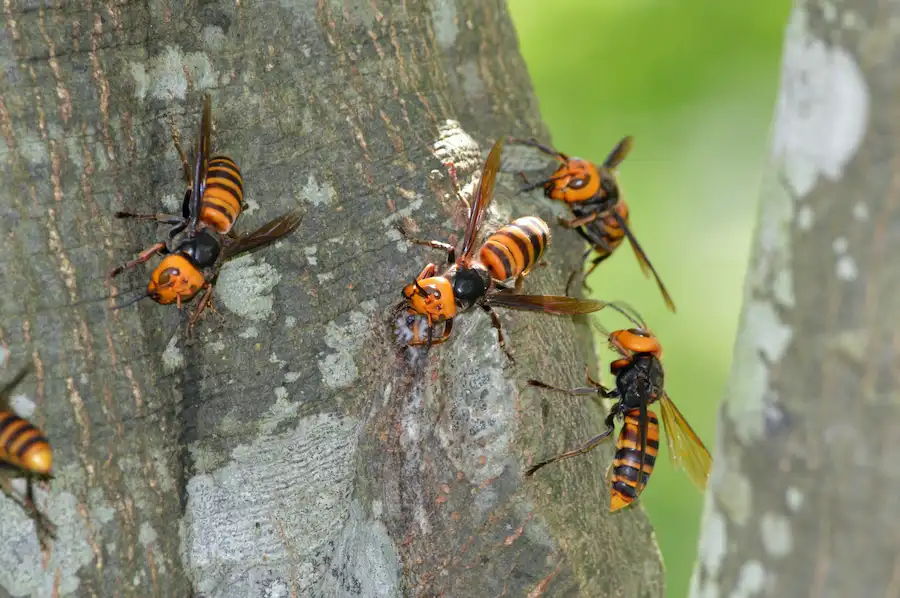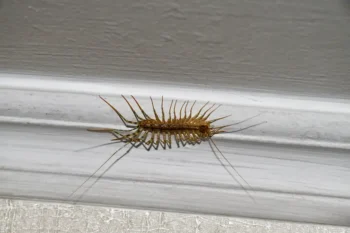
Though often dismissed as pests, bees, hornets, and wasps can pose serious risks, especially to those with allergies. One sting can cause a severe reaction. That’s why proactive prevention is key to keeping your yard protected.
Outdoor leisure loses its charm when you’re allergic to bees, hornets, or wasps. Their sudden appearances can unsettle anyone trying to enjoy their yard. The good news is that tested strategies will help prevent these pests from lingering.
Prevent stinging insects from invading your space by following these simple techniques:
- Block cracks and gaps
- Keep yard trimmed
- Skip strong scents
- Add pest-repelling plants
- Treat outdoor wood
- Inspect for insect nests
- Dress in muted tones
- Cover ground openings
- Fix leaks and puddles
- Clean up food waste
Let’s dive deeper into how these simple techniques can build a stronger line of defense against unwanted stinging insects.
Top 10 Tips for Preventing Stinging Insect Nests on Your Property
Struggling with stinging insects in your outdoor space? Bees, wasps, and hornets are drawn to areas with easy access to food, water, and shelter. Cut off those resources to make your yard less appealing. These tips can help you take back control:
1. Seal Entry Points
Examine the exterior of your home for any small cracks, gaps, or holes that might allow insects to enter. Seal these openings with caulk and cover vents or other small access points with mesh to block pests.
2. Regular Yard Care
Maintaining a neat yard discourages pests. Keep your grass trimmed, prune overgrown shrubs, and remove debris such as leaves or wood piles where insects could find shelter or build nests.
3. Fragrance Control
Strong scents attract stinging insects. Avoid using scented lotions, perfumes, or sprays when outdoors, and consider placing natural repellents like peppermint or clove oil near doors and windows.
4. Smart Landscaping
Plan your garden to reduce pest attraction. Plant insect-repelling species like mint or citronella near outdoor areas, and avoid dense vegetation that can provide nesting sites. Regularly trim back thick growth to keep your yard open and less appealing to stinging insects.
5. Protect Wood Surfaces
Untreated wood is a favorite nesting spot for carpenter bees and wasps. Applying weatherproof paint or sealant to decks, fences, railings, and play structures helps prevent damage and deters these pests. Routine inspections can catch early signs of infestation.
6. Look For Nests
Frequently inspect places like eaves, under decks, and around sheds for signs of nest building. Early detection makes removal easier. Never attempt to remove nests yourself. Always contact a professional!
7. Avoid Bright Colors
Bees and wasps are naturally attracted to bright or floral patterns resembling flowers. Wearing neutral or earth-toned clothing outdoors can help reduce unwanted attention and lower the risk of stings.
8. Fill Ground Holes
Ground-nesting insects such as yellowjackets seek open burrows. Walk your yard to find holes or depressions in the soil and fill them with dirt or gravel to eliminate potential nesting sites.
9. Fix Water Issues
Stagnant water draws thirsty stinging insects. Repair leaks in hoses, faucets, and sprinklers, and drain water that collects in pots, buckets, or low areas in your yard to reduce attraction.
10. Remove Food Sources
Food and sugary drinks quickly attract pests. Keep outdoor eating areas clean, securely cover trash bins, and promptly remove fallen fruit or spills to discourage stinging insects from visiting.
FAQs About Bee, Wasp, and Hornet Prevention
Are DIY treatments effective?
Handling stinging insects yourself can seem like the easiest option, but it often causes more issues. Common sprays tend to agitate the insects and miss nests tucked away from view. Store-bought solutions might kill a few, but not the entire colony. Experts use treatments that reach deeper and provide longer protection.
Are all stinging insects aggressive?
The way stinging insects behave under threat varies. Bees, important pollinators, typically sting only as a last resort. Meanwhile, yellow jackets and paper wasps display more hostility and will aggressively defend their nests over slight provocations.
What are some precautions to take when a hive is present?
Discovering a nest or hive close to your home can be alarming and requires careful handling. Disturbing the insects usually causes them to become defensive. Keep these tips in mind if you find one on your property:
- Observation: Monitor the nest from a distance during early morning or late at night when the insects are less active.
- Safety: Keep children and pets away from the nest to prevent accidental stings.
- Do Not Disturb: Avoid spraying, hitting, or tampering with the nest in any way.
- Timing: Stay clear of the area in the afternoon when insect activity is at its highest.
- Flight Path: Never position yourself between the nest and its entrance to reduce the risk of provoking the insects.
- Expert Help: The most effective way to remove a nest is to call a stinging insect expert who has the experience and tools to handle the job properly.
When is the Best Time to Prevent Different Types of Stinging Insects in St. Louis?
Knowing the seasonal patterns of stinging insects can help you stay one step ahead. Here’s what their behavior looks like in St. Louis:
Honey Bees
- Seasonality: Honey bees start emerging as temperatures rise in early spring, typically around March or April, and stay active until late fall. Managing swarming behavior early in the season is the best way to prevent larger issues.
- Danger Level: Moderate. Generally non-aggressive and focused on pollination, honey bees will fiercely defend their hive if threatened. Their ability to sting multiple times increases risk, especially for those with allergies.
Carpenter Bees
- Seasonality: These bees become active in early spring, around March or April in St. Louis, and remain through late summer. To discourage nesting, seal exposed wood surfaces early and inspect old boreholes in late summer when activity slows.
- Danger Level: Low. Male carpenter bees may look threatening as they hover but do not sting. Females can sting but usually only if provoked. The main concern is the damage they cause to wooden structures like decks, railings, and siding.
Paper Wasps
- Seasonality: Paper wasp activity begins in early spring when queens emerge to build nests. Colonies grow through summer and die off in fall. Preventing nests by targeting early spring activity is most effective.
- Danger Level: Moderate to high. Paper wasps are less aggressive than yellowjackets but will protect their nests. Their stings are painful and can cause allergic reactions in sensitive people.
Yellowjackets
- Seasonality: Yellowjackets appear in late spring and remain active through summer, peaking in late summer and early fall. Early control from late spring to early summer helps stop mature colonies from forming.
- Danger Level: Very high. Known for their aggression, yellowjackets attack in large groups if disturbed. They sting repeatedly and are attracted to food, which makes them a nuisance at picnics and outdoor events.
Bald-Faced Hornets
- Seasonality: Bald-faced hornets become active in late spring and stay active through early fall, with summer being their peak time. Preventive measures work best in late spring before colonies are established.
- Danger Level: High. These hornets defend their nests aggressively and can sting multiple times, posing a serious risk, especially when nests are hidden and disturbed accidentally.
Bumblebees
- Seasonality: Bumblebees are active from mid to late spring through summer into early fall. Spring is ideal for inspecting potential nesting sites like sheds, insulation, or underground burrows.
- Danger Level: Low to moderate. Usually non-aggressive, bumblebees sting only when disturbed. Their sting is painful, but the main concern is for people allergic to bee venom.
Need Help with a Stinging Insect Problem?
We are dedicated to quickly identifying and removing nests of bees, wasps, and hornets to ensure your family’s protection. Our proven techniques offer durable solutions, tailored to your unique property. Trust our team for pest control that prioritizes your peace of mind.
Book an inspection with Bug Out to safeguard your yard from stinging insects and secure your outdoor areas.
Defend Your Property Against Stinging Insects Serving Missouri
St. Louis | Chesterfield | Ballwin | St. Charles | Rock Hill
Home » Defend Your Property Against Stinging Insects





